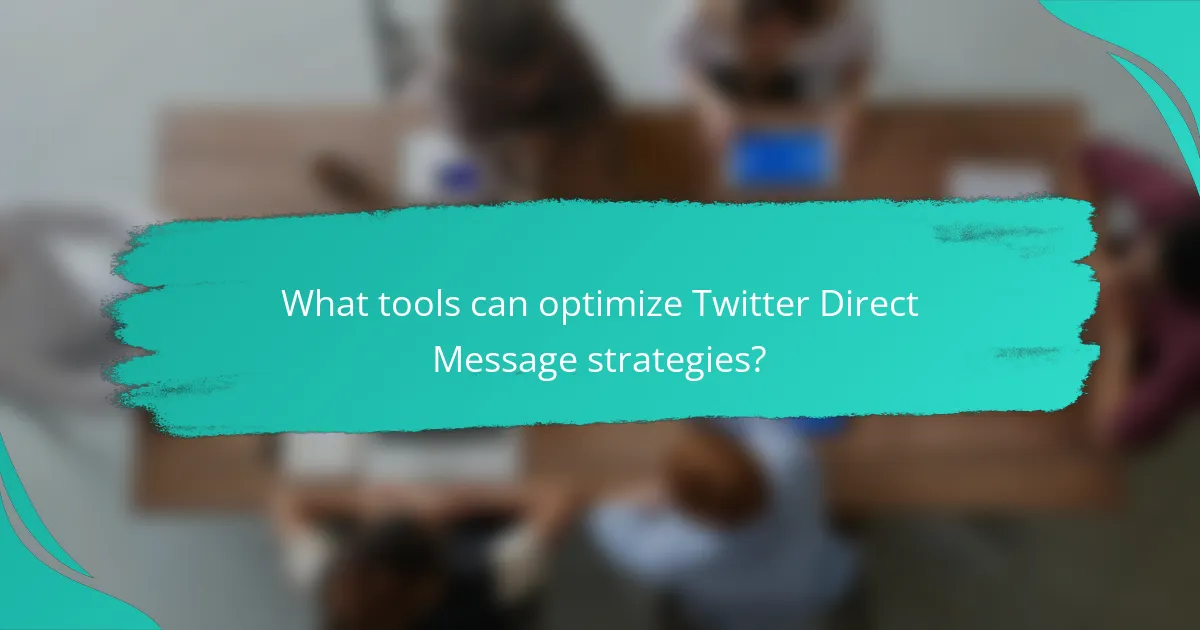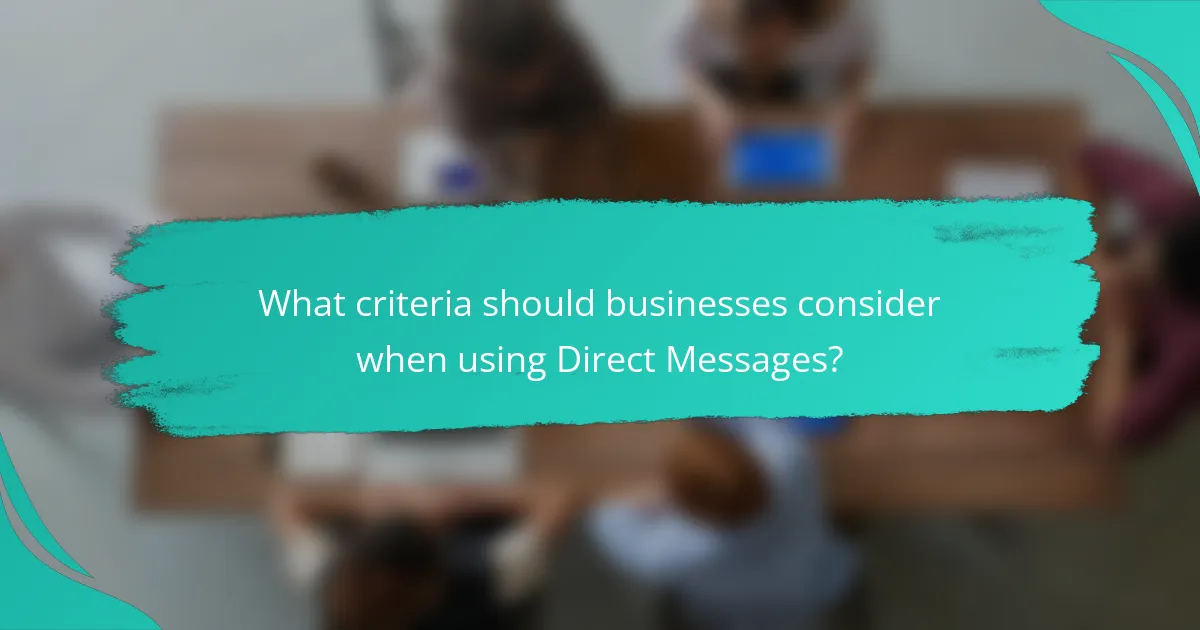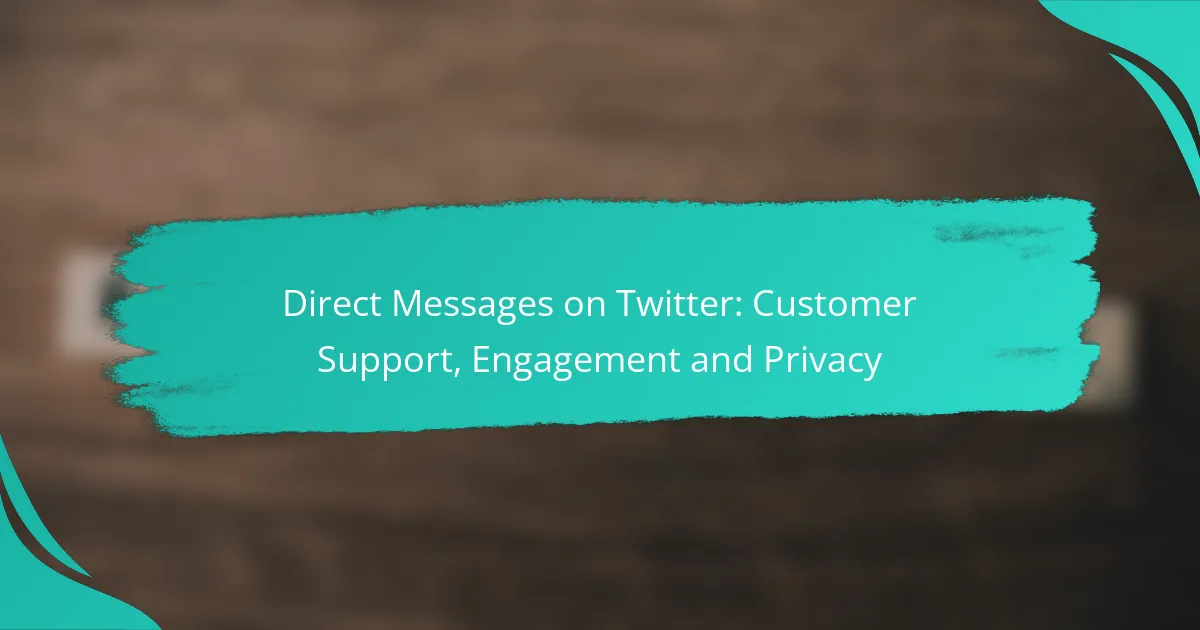Twitter Direct Messages (DMs) offer a powerful tool for brands to enhance customer support and engagement by enabling personal and immediate communication. By utilizing timely responses and automation, businesses can foster stronger relationships with their customers while ensuring a friendly interaction. Additionally, Twitter prioritizes user privacy through encryption and robust data control measures, safeguarding conversations from unauthorized access.

How can Twitter Direct Messages enhance customer support in the UK?
Twitter Direct Messages (DMs) can significantly improve customer support in the UK by allowing brands to engage with customers in a more personal and immediate manner. This platform facilitates direct communication, enabling quick resolutions and tailored responses to customer inquiries.
Real-time communication
Twitter DMs enable real-time communication between brands and customers, which is crucial for effective customer support. Customers can receive immediate responses, often within minutes, enhancing their experience and satisfaction. This immediacy helps to resolve issues before they escalate, fostering a positive relationship.
To maximize the benefits of real-time communication, brands should monitor their DMs regularly and utilize automated responses for common queries. This ensures that customers feel acknowledged even during peak times.
Personalized responses
Personalized responses in DMs can make customers feel valued and understood. By addressing customers by name and referencing their specific issues, brands can create a more engaging interaction. This tailored approach can lead to higher customer loyalty and satisfaction.
Brands should train their support teams to use customer data effectively, allowing them to provide relevant solutions and recommendations based on previous interactions. This personalization can significantly enhance the overall customer experience.
Integration with CRM tools
Integrating Twitter DMs with Customer Relationship Management (CRM) tools can streamline customer support processes. This integration allows brands to track conversations, manage customer data, and analyze interactions to improve service quality. It also helps in maintaining a consistent brand voice across different channels.
When selecting a CRM tool, consider options that offer seamless integration with Twitter and allow for easy access to customer history. This will enable support teams to provide informed responses quickly, enhancing efficiency.
Case studies from UK brands
Several UK brands have successfully leveraged Twitter DMs for customer support. For instance, a major retail chain reported a significant decrease in response times after implementing a dedicated DM team, resulting in improved customer satisfaction scores.
Another example is a telecommunications provider that used DMs to resolve billing issues swiftly, leading to a noticeable reduction in customer complaints. These case studies highlight the effectiveness of Twitter DMs in enhancing customer support and engagement.

What are best practices for engaging customers via Twitter Direct Messages?
Engaging customers through Twitter Direct Messages (DMs) requires timely responses, effective use of automation, and a friendly tone. These practices help build rapport, improve customer satisfaction, and enhance overall engagement.
Prompt response times
Quick response times are crucial for effective engagement via Twitter DMs. Aim to reply within a few minutes to ensure customers feel valued and heard. A response time of under 15 minutes is often considered ideal for maintaining customer interest.
To manage response times, consider setting up alerts for incoming messages and designating team members to monitor DMs during peak hours. This proactive approach can significantly enhance customer experience.
Using automated replies
Automated replies can streamline the initial interaction with customers, providing instant acknowledgment of their messages. Use automated responses to inform customers that their inquiry has been received and that a representative will follow up shortly.
However, ensure that automated messages are personalized and relevant. Avoid generic replies; instead, tailor them to common inquiries to maintain engagement and reduce frustration.
Maintaining a friendly tone
A friendly and approachable tone is essential when engaging customers through Twitter DMs. Use casual language and emojis where appropriate to create a welcoming atmosphere. This helps in building a connection and makes customers feel comfortable reaching out.
Be mindful of the customer’s mood and adjust your tone accordingly. If a customer is frustrated, acknowledge their feelings and respond with empathy. This approach can turn a negative experience into a positive one, fostering loyalty and trust.

How does Twitter ensure privacy in Direct Messages?
Twitter employs various measures to ensure privacy in Direct Messages (DMs), focusing on encryption, user data control, and a clear privacy policy. These features help protect users’ conversations from unauthorized access and enhance overall security.
End-to-end encryption
Twitter does not currently implement end-to-end encryption for Direct Messages, meaning that while messages are encrypted during transmission, they can be accessed by Twitter itself. This approach allows for features like spam detection and account recovery but raises concerns about message confidentiality.
Users should be aware that without end-to-end encryption, their DMs may be vulnerable to interception by third parties or unauthorized access. For sensitive conversations, consider using platforms that offer stronger encryption standards.
User control over data
Twitter provides users with options to manage their data privacy, including the ability to delete messages and control who can send them DMs. Users can adjust their privacy settings to limit direct messaging to followers only or to block specific accounts.
It’s crucial for users to regularly review their privacy settings and understand how their data is being used. Familiarizing oneself with these controls can help mitigate risks associated with unwanted messages or data exposure.
Privacy policy overview
Twitter’s privacy policy outlines how user data is collected, used, and shared, including specifics about Direct Messages. The policy emphasizes user consent and transparency regarding data handling practices.
Users should read the privacy policy to understand their rights and the measures Twitter takes to protect their information. Regular updates to the policy may occur, so staying informed is essential for maintaining privacy on the platform.

What tools can optimize Twitter Direct Message strategies?
To enhance Twitter Direct Message strategies, businesses can utilize various tools that streamline communication, automate responses, and analyze engagement. These tools help improve customer support efficiency and foster better engagement with followers.
Twitter Business Dashboard
The Twitter Business Dashboard is a built-in tool that provides insights into account performance, including Direct Message interactions. It allows businesses to manage messages, track response times, and view customer engagement metrics all in one place.
Utilizing the dashboard can help identify peak messaging times and common customer inquiries, enabling businesses to tailor their responses effectively. Regularly reviewing these metrics can lead to improved customer satisfaction and quicker resolution times.
Third-party automation tools
Third-party automation tools, such as Chatbots and customer service platforms, can significantly enhance Direct Message strategies on Twitter. These tools can automate responses to frequently asked questions, allowing businesses to provide instant support without constant manual input.
When selecting an automation tool, consider factors like integration capabilities, ease of use, and customization options. Popular tools include ManyChat and Zendesk, which can help streamline communication while maintaining a personal touch in interactions.
Analytics platforms for engagement tracking
Analytics platforms like Hootsuite or Sprout Social can track engagement metrics related to Direct Messages on Twitter. These platforms provide detailed reports on response rates, customer sentiment, and overall engagement trends.
By analyzing this data, businesses can refine their messaging strategies, identify successful engagement tactics, and address any areas needing improvement. Regularly reviewing analytics can help ensure that customer support efforts align with audience expectations and preferences.

What criteria should businesses consider when using Direct Messages?
Businesses should consider target audience preferences, response time expectations, and brand voice consistency when using Direct Messages on Twitter. These criteria help ensure effective communication and enhance customer satisfaction.
Target audience preferences
Understanding your target audience’s preferences is crucial for effective Direct Messaging. Different demographics may prefer varying levels of formality, response times, and even the types of content shared. For instance, younger audiences might appreciate a more casual tone, while older customers may favor professionalism.
Additionally, consider the preferred communication channels of your audience. Some users may prefer direct messages over public tweets for privacy reasons, while others might enjoy the transparency of public interactions. Tailoring your approach to these preferences can significantly improve engagement.
Response time expectations
Response time is a critical factor in customer satisfaction when using Direct Messages. Customers typically expect replies within a few hours, with many businesses aiming for a response time of under one hour during business hours. Delays can lead to frustration and a negative perception of your brand.
To manage expectations, set clear guidelines for response times and communicate them to your audience. Automated replies can also help acknowledge inquiries while customers wait for a more personalized response. This approach keeps customers informed and engaged.
Brand voice consistency
Maintaining a consistent brand voice across Direct Messages is essential for building trust and recognition. Your messaging should reflect your brand’s personality, whether it’s friendly, authoritative, or humorous. Inconsistencies can confuse customers and dilute your brand identity.
Develop guidelines for your brand voice that can be easily referenced by team members handling Direct Messages. Regular training and reviews can help ensure that everyone communicates in a way that aligns with your brand values, enhancing the overall customer experience.

What are the emerging trends in Twitter Direct Messaging?
Emerging trends in Twitter Direct Messaging (DM) highlight the platform’s evolving role in customer support and engagement. Businesses are increasingly leveraging DMs for personalized interactions while ensuring user privacy and security.
AI-driven customer interactions
AI technology is transforming customer interactions on Twitter by enabling automated responses and chatbots. These tools can handle common inquiries, providing quick answers and reducing wait times for users. Businesses can implement AI solutions to streamline their support processes, enhancing customer satisfaction.
However, while AI can efficiently manage routine questions, it is crucial to maintain a human touch for more complex issues. Companies should regularly monitor AI interactions to ensure quality and adjust responses based on customer feedback.
Increased use of multimedia
Multimedia elements, such as images, videos, and GIFs, are becoming essential in Twitter DMs to enhance engagement. These formats can convey information more effectively than text alone, making interactions more dynamic and appealing. For instance, a customer support team might use a short video tutorial to resolve a user’s issue quickly.
When incorporating multimedia, businesses should ensure that content is relevant and accessible. Using clear visuals can help clarify instructions or showcase products, but it’s important to avoid overwhelming users with excessive media. A balanced approach can significantly improve the overall customer experience.
